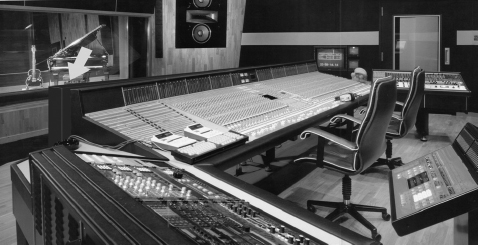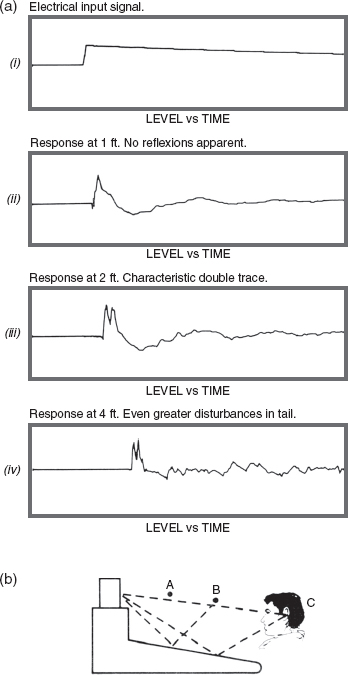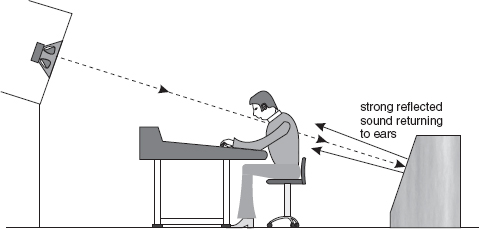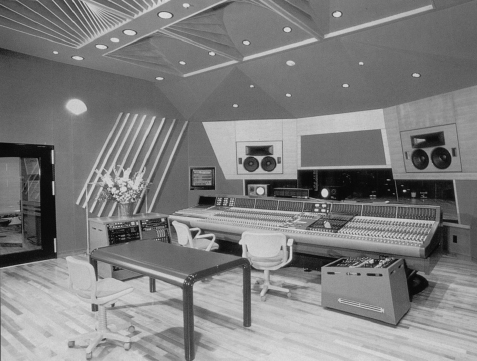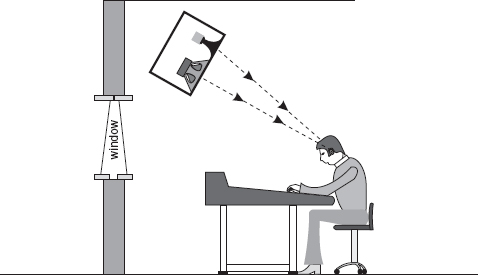CHAPTER 18
Response Disturbances Due to Mixing Consoles and Studio Furniture
Mixing consoles as acoustic obstructions. Equipment rack sizes and placement. Computers and their monitors. Sofas. Siting of monitor loudspeakers.
One basic limitation relating to the carefully calculated modal spread of some of the preferred ratios of room dimensions, discussed in Chapter 12, is that they all presume hard-walled, rectangular, empty rooms. The response of a loudspeaker in a carefully designed control room tends also to be calculated in terms of the empty room response. Once a large amount (or in some cases even a small amount) of equipment is placed in a room, both the modal response and the transfer function from the loudspeakers to the listening position will be altered, and sometimes drastically so.
No audiophiles would be likely to place their dining room tables and sideboards between themselves and their hi-fi loudspeakers, yet recording engineers, from necessity, do much worse things. They place large, resonant, reflective, absorptive, diffusive, diffractive objects (mixing consoles) between themselves and the monitor loudspeakers, and often, without due care and attention, position effects racks and computer monitors in places where disturbance of the monitor responses is effectively guaranteed to occur.
18.1 The Sound of Mixing Consoles
Historically, remarkably little thought was given to the way in which the physical presence of a mixing console could disturb the acoustics of a room, but as the better control room responses improved, sometimes great differences were noticed in the sound of the monitoring when an older console was replaced by a newer one. Size is important. In general, the smaller the mixing console, relative to the size of the room, the less will be the response disturbance. Somewhat perversely, out of ignorance and/or disregard for the monitoring quality, the business people who frequently dictate what happens in studios often also choose to put the largest mixing console that they can afford into a room, in the belief that it will impress the clients. This has a greater tendency to happen in smaller, less professionally operated studios, which are often the ones that are already marginal in terms of the quality of their monitoring.
When digital consoles were first being discussed, many of their designers predicted the 1 m2 (or less) control surface, with the rest of the electronics being housed in a machine room. To many studio designers this seemed to be a definite step in the right direction, but the use of such systems has not become widespread. The aforementioned ‘macho’ sales value of the large console is one reason, despite being a triumph of marketing over sound quality. However, the other principal argument against the use of such small surfaces has come from the recording engineers, who need rapid access to all controls during large and pressurised recording sessions. There is often simply no time to leaf through menus in order to gain access to the required control. In small, single operator studios, which usually do not deal with large groups of expensive musicians on tight schedules, the slower access time of small control surfaces is often no great disadvantage, but these are frequently precisely the studios where ignorance exceeds experience and they opt for unnecessarily large consoles in order to appear more ‘up-market’.
The worst offenders in terms of disturbing the monitor response are the mixing consoles with closed backs which extend from the meter bridge to the floor. The rear surfaces of such consoles are normally vertical, and they can form resonant spaces between the consoles and the front walls. They also obstruct the free expansion of the low frequency sound waves under the console, which causes undesirable amounts of diffraction, resulting in the subsequent disturbances in the frequency response, transient response and the stereo imaging. What is more, the large backs are rarely adequately damped, so they can rattle and resonate, thus both adding to and subtracting from the desired flat response. Some mixing consoles, it must be said, bring disgrace to their manufacturers by the sheer degree of disregard that they have paid to the acoustic intrusion of their products.
Metal panels underneath many mixing consoles can also be heard to ring in response to drum beats. Investigators at Vigo University, Spain, found that the decay time of an expensive control room which they measured, with otherwise excellent acoustics, was dominated by the resonance of the tubular steel frame of its ostensibly professional mixing console. It is interesting to note that when AMS/Neve launched their 88 R mixing console in late 2000, they made a point of advertising its minimal use of enclosing panels and the shallow inclined rear surface, both designed to minimise the acoustic disturbance to the control rooms. This is something for which they should be applauded, despite it having taken them over 35 years to correct their earlier oversights.
Studio designers have reported that significant differences in the response of control rooms, of very similar size and with identical monitor systems, have resulted from the installation of different mixing consoles. The tests have been carried out with the noise or music sources connected directly to the monitor systems, to avoid the possibility of the differences being due to the monitor circuitry of the consoles. Considerable changes of monitoring quality have been apparent when one mixing console has been changed for another of very different shape.
In fact, in some cases where a room has had a poor reputation for its monitoring, even though all electroacoustic consideration suggested that the room should be good, a change of mixing console from one that caused severe obstruction to the sound waves to one of smaller size has improved the monitoring by a significantly noticeable degree. This has even been the case when the replacement console was of lesser quality in terms of its electronic signal path. It has been rather unfortunate that some of the best mixing consoles, electronically speaking, have been the worst offenders in acoustic terms.
In general, a large mixing console needs to be installed in a large room, or its presence may dominate the acoustics in a small room to such a degree that the problems encountered cannot be remedied. There is a tendency for studio owners to want to fill their control rooms with all sorts of impressive looking equipment, but the temptation should be resisted or the monitoring quality will suffer. The installation of excessive quantities of equipment should be avoided.
It is also usually wise to remove all metal panels that are not necessary, and to add self-adhesive damping materials to the panels that must remain. Typical damping materials are the ones used in the automobile industry. However, before permanently removing any panels, the mixing console manufacturers should be consulted because it can, in some circumstances, change the air flow such that hot spots can develop in places where the convective air flow has been disturbed.
Another beneficial addition is an absorbent screen placed behind the mixing console. This could be in the form of a frame with heavily pleated curtains, or fabric-covered and filled with 20 cm of open-cell foam, cotton felt or mineral wool. Such a device is shown in Figure 18.1. Once again, care must be taken when positioning the screen to ensure that none of the ventilation slots or holes on the rear of the desk is obstructed or overheating may result. Such screens can also be useful as stands for the small monitor loudspeakers, because mounting the small monitors a little distance away from the console is usually preferable to mounting them directly on the console itself. Low frequency colouration is usually greater when a large plane surface, such as the control surface of a mixing console, is positioned directly below the loudspeakers. Figure 18.2 shows the effect of desktop mounting on the transient response, and neither colouration nor transient smearing is beneficial in terms of monitoring quality or stereo imaging.
18.2 Equipment Racks
There are many things done in control rooms these days which are for convenience much more than they are for accurate monitoring. In many studios, the monitors are mounted higher than ideal in order to allow a greater width of window, and an effects rack is mounted behind the mixing position and set at an angle for best visibility of the controls. Figure 18.3 shows the way in which the monitor height and effects rack angle combine to cause strong reflexions to return to the back of the engineer’s head, typically 10 or 15 ms after the first pass of the direct sound, and only very slightly reduced in level. Strong comb filtering can result, and stereo image smearing can be considerable. It is often the case in such control rooms that the large monitors are not considered to sound very good. Figure 18.4 shows a control room where all equipment furniture is kept low, and is angled such that reflexions pass away from the mixing console. Perhaps such a system is not always quite as convenient as the rear-rack/keyboard-table approach, but if good monitoring conditions are desired then certain small compromises must often be made in terms of convenience.
Figure 18.1:
Acoustic screen to suppress console reflexions (indicated by the arrow). A freestanding screen can be mounted behind the mixing console, spaced away by 15–20 cm to allow free ventilation if necessary. The screen should be around 20 cm thick, and should consist of an outer, rectangular frame filled with 60–80 kg/m3 open cell foam slabs or wedges. Such a screen effectively eliminates reflexions between the console and the front wall or window. The screen also provides a better mounting location for close-field monitor loudspeakers than the meter bridge of the mixing console. A layer of foam on the meter bridge, immediately in front of the loudspeakers, helps even more (Nomis, London, UK, 1989).
18.3 Computer and Video Monitoring
Another case where convenience triumphs over good monitoring is when a mountain of computer and video monitors is placed such that they not only cause undesirable reflexions, but also obstruct the direct path from the loudspeakers to the engineers’ ears. When studio owners and operators are questioned about this practice, the answer is often that it must be all right because of all the photographs seen in recording magazines showing famous studios elsewhere employing similar arrangements. The truth is that when photographs are being taken for magazines, the studio personnel often want to get the maximum publicity value from showing off as much of their equipment as possible. What is more, a photograph may be taken during vocal overdubbing, for example, but the situation with equipment clutter may be much better organised during serious mixing. The phase of the work during which the photographs were taken is rarely noted in the captions. The truth, also, is that many bad practices go on even in expensive studios. Ignorance is rife these days.
Figure 18.2:
Close-field monitor response: (a) The effect of the reflexions from the top surface of a mixing console on the transient response of a small loudspeaker placed on the meter bridge; (b) Loudspeaker directivity is too narrow to produce reflexions at position ‘A’. However, reflexions are apparent at positions ‘B’ and ‘C’, with differing ratios of direct to reflected path lengths, hence they produce the different composite transient waveforms as in (a) (iii) and (iv). Positions ‘A’, ‘B’ and ‘C’ relate to the 1, 2 and 4 foot plots in (a) (30, 60 and 120 cm respectively).
Figure 18.3:
In many cases, an effects rack placed behind the engineer, for easy access, also performs the function of an acoustic mirror, returning strong reflexions to the prime listening positions. This is especially problematical when the main monitor loudspeakers are mounted high.
Figure 18.4:
Hitokuchi-Zaka studios, Tokyo, Japan. In this control room, designed by Shozo Kinoshita, all furniture is kept below ear height, and is positioned to avoid confusing reflexions. Although the monitor loudspeakers are mounted relatively high, the size of the room ensures that the monitoring angle is kept low.
Nevertheless, there is definitely a trend towards allowing equipment to dominate many proceedings, and this reality must be recognised. However, the principal aim of this book is to take the purist point of view. Many studio owners and operators have simply never fully understood the repercussions of many of their actions, and do not even stop to consider what a pile of close-field loudspeakers and computer monitor screens may be doing to the main audio monitoring. Only by carefully pointing out the effects, and demonstrating them if possible, can they be put in a position to make their own balanced decisions about the priorities. Certainly, whilst overdubbing a guitar or making a quick recording for a TV jingle, convenience of operation may take precedence. However, when setting up to mix what is likely to be a million-selling CD, the record-buying public really deserve a little more consideration, because they are perhaps going to be listening to the results of the session for 30 years or more.
When possible, it is ideal from an acoustic point of view to mount video monitors in the front wall, but this should be done in such a way that no resonant cavities are formed, and no diffractive edges are too close to the loudspeakers. The new flat screens seem to be better than large cathode-ray video screens, because of their reduced physical presence and the ability to lie them down or move them into less intrusive positions when audio monitoring of a high resolution is required. Wherever possible, video monitors are best kept to the sides of the mixing console if they cannot be mounted in, or very close to, the front wall.
Hopefully, as computer-based recording equipment develops it will become more acoustically friendly, but one of the problems has been that many of the people who have been developing the equipment have not been ‘audio people’ in the traditional sense. Large amounts of money have been involved and the mathematical input has been enormous. Such developments are not made just for the benefit of a relatively few high-quality studios. They imply mass sales in order to get a return on the financial investments, so they lead to products that are largely aimed at a mass market. Acoustical niceties therefore tend to be well down the list of priorities. It has been a general fact of life since the early 1980s that dedicated specialist manufacturers for the professional recording industry have been becoming a dying breed. It therefore becomes an encumbrance upon the studio operators to find acoustically acceptable solutions for the appropriate mounting of their monitor screens.
18.4 Sofas
Sofas can be very useful in control rooms, not only to sit on, but also because they are generally good low frequency absorbers. Their physical depth makes them effective even when placed against walls. Generally speaking, fabric covered sofas are preferable because the leather and plastic covered varieties can be reflective at high frequencies, although their irregular shape usually makes the reflexions rather diffuse. From a non-acoustic point of view, the comfort that a sofa provides for producers and musicians is often greatly appreciated, and they are generally well received.
In larger rooms, where there is sufficient space between the mixing console and the front wall, it is sometimes possible to place a sofa in such a position that it can take the place of a purpose made acoustic screen to reduce the rear-panel reflexions from the mixing consoles. Sofas in this position can also have the beneficial effect of reducing floor reflexion response dips at the mixing position.
18.5 Effects Units and Ventilation
It is always best in a sound control room to avoid having anything higher than about 1m. The meter bridge of the mixing console may have to exceed this for operational reasons, but racks should be kept to a height of around 90 cm in order that things placed on top of them should remain below 1 m. Computer monitors tend to break this rule, but their positioning for minimal acoustic disturbance has been dealt with in Section 18.3. When things begin to exceed 1m in height, disturbances to the stereo imaging are likely to result. Metal racks should be avoided at all cost, unless they are of an open-frame, skeletal nature. Wood is the preferable material, of sufficient thickness not to resonate under normal conditions of use.
Ventilation can be provided by grilles, semi-open backs and spaces between the equipment, but fans should not be used as they inevitably contribute to the ambient noise in a most undesirable way. Obviously this type of ventilation is not suitable for densely packed equipment, but a high packing density is often a necessary result of inadequate space in the control room itself. Again, it is often the fact that people tend to build control rooms in spaces that are too small, which in turn forces equipment into spaces that are too tight, and undesirable measures then need to be taken to stop things from overheating.
18.6 Close-Field Monitors
There is an obvious conflict of priorities when it comes to the siting of small loudspeakers in the vicinity of a mixing console. Ideally, the main and secondary monitors both need to subtend the same angle in the area of the head of the recording engineer. If the subtended angles were the same, the small loudspeakers would need to be positioned directly in line between the main loudspeakers and the engineer. It would seem to be reasonable common sense that placing such obstructions in the direct line of sight to the principal monitors could do nothing other than disturb their response. However, the question may arise as to which ones are the principal monitors during different phases of the recording, overdubbing and mixing processes.
It is common to see the meter bridge area of a mixing console so loaded with different small loudspeakers and computer monitors that the large monitor loudspeakers are all but invisible from the mixing position. This is clearly an absurd situation, but it has been known to exist in some large and well-known studios. Quite how these situations arise in supposedly professional studios is hard to understand, except perhaps as an attempt to please all the clients by having all their favourite small loudspeakers on display, but it often drives a vicious circle. The main monitors sound less than good because of the first obstructions, so they are relied upon less. More small references are therefore introduced, which make the main monitors sound even worse, so the small monitors are relied on still more.
Another aspect of the fight for position is that in many cases the small loudspeakers are laid flat so that they obstruct less the view of the large monitors. As Figure 18.5 shows, many manufacturers are now clearly stating the intended orientation of the loudspeakers. When the drivers are aligned vertically, lateral movement of the engineer across the mixing console will cause no change in the relative distances from the high and low frequency drive units. If the loudspeakers are laid on their sides, and the drivers no longer share a common vertical axis, phasing effects may be heard during lateral movement and the off-axis colouration will be greater than when aligned vertically. This can be very easily demonstrated by listening to pink noise. Figure 13.11 shows the general principle, which can give rise to a further lack of compatibility between large and small monitors. Even if the two are highly compatible when listening exactly on the centre line between left and right, when the small loudspeakers (other than dual concentrics) are laid on their sides it is almost impossible to expect to be able to maintain that compatibility even when one moves only 5° or so off-axis. The practice of laying the small loudspeakers on their sides is usually a rare attempt to reduce the obstruction of the main monitoring, yet it is unwittingly done at the cost of the close-field monitoring qualities.
Figure 18.5:
Correct use of small loudspeakers. More and more loudspeaker manufacturers, such as Tannoy, Quested and Genelec are now publishing drawings, such as those above, in their manuals for small loudspeakers, instructing their users to keep the drivers in a common vertical plane. It matters nought that there are thousands of studios using such loudspeakers on their sides, the practice is WRONG (see also Figures 13.11 and 13.12).
Figure 18.6:
When monitor loudspeakers are mounted at a steep angle, the high frequencies, in particular, arrive at the ears from an angle totally inappropriate for the perception of an accurate frequency balance. High frequencies will tend to be under-perceived when looking at the equalisation controls on the mixing console. What is more, unless the ceiling is highly absorbent, the low frequencies may suffer undue augmentation due to the proximity of multiple room boundaries.
One attempted ‘solution’ to this problem is to mount the large monitors sufficiently high that there is a clear line of sight to them above the desktop obstructions, but there are drawbacks to this practice. Firstly, a large amount of equipment just below the loudspeaker axis will still inevitably cause colouration due to the reflexion, diffraction and diffusion from surfaces previously ‘hidden’ from the loudspeakers, so little may be gained. Secondly, when the monitors are mounted high, and an engineer is looking at the control surface of the mixing console, the sound is arriving at the ears from a position almost 90° above the normal listening axis, as shown in Figure 18.6. In such cases, the perception of high frequencies will be different from when directly facing the loudspeakers. This leads to the tiresome experience of constantly needing to look up at the loudspeakers after every adjustment, in order to audibly check the effect. If this is not done it can lead to incorrect conclusions about the equalisation.
18.7 General Commentary
All the above effects are rather subtle, but cumulative. Nevertheless, even if some of them are only marginally noticeable in isolation, the difference between a control room where they have all been taken into account and one in which no such consideration has taken place can be very noticeable indeed. The difference is not even always apparent for what it is. It is rather that well thought out control rooms, in which many small details have been taken into account, tend simply to induce a feeling of confidence in the people using them. This no doubt results from a general awareness of the better quality of the monitoring conditions and the lack of confusing cues.
Although easy access to equipment is a very important part of the functionality of a control room, the tendency to box-in the listening area by portable racks is absolutely asking for inaccurate monitoring. This practice will affect the responses of the small loudspeakers also. Placing so many reflective surfaces in the vicinity of the ears is simply inviting trouble.
Most studio personnel have not had the opportunity to hear a well-designed control room with only its monitor system installed. This is unfortunate, because if more people could hear what the rooms were capable of sounding like before the rest of the equipment was installed, it may inspire them to take a little more care about the acoustic consequences of the equipment positioning. It may also inspire them to ask the equipment manufacturers a few more questions about their design philosophies, which would also do the whole industry a great favour.
18.8 Summary
Few audiophiles would put their dressing table and a few chests of drawers between themselves and their hi-fi loudspeakers, yet that is no less reasonable than that which occurs in most recording studios.
Mixing consoles should be proportionate in size to the control rooms in which they are situated. A mixing console that occupies a great proportion of the space in a control room will inevitably negatively affect the sound quality of the monitor system.
Large mixing consoles should not be chosen for their ability to impress clients, because a price will be paid in terms of monitoring accuracy. Acoustically speaking, the rule for mixing consoles is ‘the smaller, the better’.
If the panels on the back and underside of mixing consoles can be removed, or treated with self-adhesive damping materials, it is often wise to do so.
The monitoring character of control rooms has been known to change significantly with the change of a mixing console.
Absorbent screens behind the mixing consoles can be advantageous to the monitoring.
Equipment racks should be kept low.
Slanted equipment racks behind the recording engineer’s head should be avoided.
Computer monitors should be kept to the side of the mixing console during serious mixing sessions. Ideally, they should be positioned well out of the way of the line of sight to the loudspeakers.
Convenience should not be allowed to dominate decisions at the expense of monitoring quality.
Sofas are generally beneficial, either at the back of a room or between the mixing console and the front wall.
Close-field monitors are better placed on stands behind the mixing console, rather than on the meter bridge. (But see also Chapter 19.)
Small loudspeakers should be mounted with the common axis of the drive units in a vertical line. Despite the label on the front of the NS10M Studio suggesting a horizontal (landscape) position, this is not a good idea. Images are less stable and more ‘phasey’ when drivers are offset horizontally.
Mounting the main monitors high up is not a good idea. The acoustic centres of the monitors should be sited low enough to reduce desktop reflexions and to keep the timbre constant for people moving around the room. (See also Subsection 20.7.1.)
Bibliography
Newell, Philip, ‘The Acoustics of Mixing Consoles’, Studio Sound, Vol. 33, No. 8, pp. 59–63 (August 1991)
Newell, Philip, Studio Monitoring Design, Chapter 14, Focal Press, Oxford, UK (1995)

